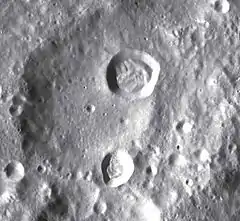 LRO image, with Ventris A above center and Ventris M below center | |
| Coordinates | 4°54′S 158°00′E / 4.9°S 158.0°E |
|---|---|
| Diameter | 95 km |
| Depth | Unknown |
| Colongitude | 203° at sunrise |
| Eponym | Michael Ventris |

Ventris is a lunar impact crater on the far side of the Moon. It is located between the crater Schliemann just to the northwest and the large Keeler which lies slightly farther to the southeast. One crater diameter to the northeast is Vening Meinesz.
Since it was formed, this crater has been heavily worn and eroded by subsequent impacts. Multiple craters lie across the rim and within the interior. The largest of these is Ventris C covering the northeastern rim. In the northern part of the floor is Ventris A. The southern floor contains Ventris M, a fresh impact crater with a small ray system and a relatively high albedo. The rays from this satellite extend in a skirt that covers most of Ventris. Narrower rays extend much farther to the northwest and southwest.
Satellite craters
By convention these features are identified on lunar maps by placing the letter on the side of the crater midpoint that is closest to Ventris.
| Ventris | Latitude | Longitude | Diameter |
|---|---|---|---|
| A | 4.4° S | 158.2° E | 26 km |
| B | 2.4° S | 158.2° E | 18 km |
| C | 3.2° S | 158.9° E | 48 km |
| D | 3.4° S | 160.3° E | 21 km |
| M | 6.0° S | 157.9° E | 18 km |
| N | 7.1° S | 157.6° E | 63 km |
| R | 6.3° S | 155.1° E | 13 km |

References
- Andersson, L. E.; Whitaker, E. A. (1982). NASA Catalogue of Lunar Nomenclature. NASA RP-1097.
- Blue, Jennifer (July 25, 2007). "Gazetteer of Planetary Nomenclature". USGS. Retrieved 2007-08-05.
- Bussey, B.; Spudis, P. (2004). The Clementine Atlas of the Moon. New York: Cambridge University Press. ISBN 978-0-521-81528-4.
- Cocks, Elijah E.; Cocks, Josiah C. (1995). Who's Who on the Moon: A Biographical Dictionary of Lunar Nomenclature. Tudor Publishers. ISBN 978-0-936389-27-1.
- McDowell, Jonathan (July 15, 2007). "Lunar Nomenclature". Jonathan's Space Report. Retrieved 2007-10-24.
- Menzel, D. H.; Minnaert, M.; Levin, B.; Dollfus, A.; Bell, B. (1971). "Report on Lunar Nomenclature by the Working Group of Commission 17 of the IAU". Space Science Reviews. 12 (2): 136–186. Bibcode:1971SSRv...12..136M. doi:10.1007/BF00171763. S2CID 122125855.
- Moore, Patrick (2001). On the Moon. Sterling Publishing Co. ISBN 978-0-304-35469-6.
- Price, Fred W. (1988). The Moon Observer's Handbook. Cambridge University Press. ISBN 978-0-521-33500-3.
- Rükl, Antonín (1990). Atlas of the Moon. Kalmbach Books. ISBN 978-0-913135-17-4.
- Webb, Rev. T. W. (1962). Celestial Objects for Common Telescopes (6th revised ed.). Dover. ISBN 978-0-486-20917-3.
- Whitaker, Ewen A. (1999). Mapping and Naming the Moon. Cambridge University Press. ISBN 978-0-521-62248-6.
- Wlasuk, Peter T. (2000). Observing the Moon. Springer. ISBN 978-1-85233-193-1.